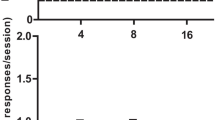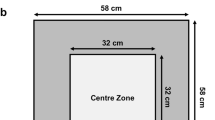Abstract
The interoceptive stimulus produced by pentylenetetrazol (PTZ) is pharmacologically similar to anxiety and is used in a behavioral assay for anxiety-related stimuli (the PTZ model of anxiety). The stimulus fading technique was tested as a method to increase the sensitivity of this assay. Rats were trained with food-reward to press one lever after injection of PTZ and an alternate lever after saline. Rats initially learned the discrimination at a PTZ dose of 20 mg/kg. They were then trained with sequentially lower doses until they reliably discriminated a PTZ dose of 10 mg/kg. Substitution test with other doses and drugs showed that, after the fading procedure, dose-response curves were shifted to lower doses for PTZ, Ro 5-3663, and nicotine. Similarly, the dose of diazepam required to block the low dose of PTZ was lower than that required to block the higher dose of PTZ. These results indicated that the sensitivity of the discrimination was enhanced in rats trained to discriminate a lower dose of PTZ. Doses of nikethamide, cocaine, and yohimbine that did not substitute for the higher dose of PTZ also did not substitute for the lower dose. These data suggest that rats can be trained to discriminate a low dose of PTZ by the stimulus fading technique. Moreover, they suggest that this training method does not compromise the specificity of the discrimination.
Similar content being viewed by others
References
Bernard PS, Bennett DA, Pastor G, Yokoyama N, Liebman JM (1985) CGS 9896: agonist-antagonist benzodiazepine receptor activity revealed by anxiolytic, anticonvulsant and muscle relaxation assessment in rodents. J Pharmacol Exp Ther 235:98–105
Colpaert FC, Janssen PAJ (1982) Factors regulating drug cue sensitivity: limits of discriminability and the role of a progressively decreasing training dose in cocaine-saline discrimination. Neuropharmacology 21:1187–1194
Colpaert FC, Kuyps JJMD, Niemegeers CJE, Janssen PAJ (1976) Discriminative stimulus properties of a low dl-amphetamine dose. Arch Int Pharmacodyn 223:34–42
Colpaert FC, Niemegeers CJE, Janssen PAJ (1980) Factors regulating drug cue sensitivity: limits of discriminability and the role of a progressively decreasing training dose in fentanyl-saline discrimination. J Pharmacol Exp Ther 212:474–480
De Vry J, Slangen JL (1986) Effects of chlordiazepoxide training dose on the mixed agonist-antagonist properties of benzodiazepine receptor antagonist Ro 15-1788, in a drug discrimination procedure. Psychopharmacology 88:177–183
Emmett-Oglesby MW, Herz A (1987) Opioid modulation of the discriminative stimulus produced by pentylenetetrazol. Psychopharmacology 92:313–319
Emmett-Oglesby MW, Spencer DG Jr, Arnoult DE (1982) A TRS-80-based system for the control of behavioral experiments. Pharmacol Biochem Behav 17:583–587
Greenberg I, Kuhn DM, Appel JB (1975) Behaviorally induced sensitivity to the discriminable properties of LSD. Psychopharmacologia 43:229–232
Harris CM, Benjamin D, Lal H (1987) Anxiety-like subjective effect of ethanol antagonist Ro 15-4513 demonstrated in pentylenetetrazol discrimination. Neuropharmacology 26:1545–1547
Harris CM, Emmett-Oglesby MW, Mathis DA, Lal H (1988) Quantal detection and homogeneous sensitivity in a pentylenetetrazol discrimination. Psychopharmacology 94:183–187
Jensen LH, Petersen EN, Braestrup C, Honore T, Kehr W, Stephens DN, Schneider H, Seidelmann D, Schmiechen R (1984) Evaluation of the β-carboline ZK 93 426 as a benzodiazepine receptor antagonist. Psychopharmacology 83:249–256
Lal H, Emmett-Oglesby MW (1983) Behavioral analogues of anxiety: animal models. Neuropharmacology 22:1423–1441
Lal H, Fielding S (1984) Antagonism of discriminative stimuli produced by anxiogenic drugs as a novel approach to bioassay anxiolytics. Drug Dev Res 4:3–21
Overton DA (1979) Drug discrimination training with progressively lowered doses. Science 205:720–721
Overton DA (1982) Comparison of the degree of discriminability of various drugs using the T-maze drug discrimination paradigm. Psychopharmacology 76:385–395
Peto R, Pike MC, Day NE, Gray RG, Lee PN, Parish S, Peto J, Richards S, Wahrendorf J (1980) Guidelines for simple, sensitive significance tests for carcinogenic effects in long-term animal experiments. WHO, IARC Monogr [Suppl] 2:311–425
Shannon HE, Holtzman SG (1979) Morphine training dose: a determinant of stimulus generalization to narcotic antagonists in the rat. Psychopharmacology 61:239–244
Shearman GT, Lal H (1979a) Discriminative stimulus (DS) properties of picrotoxin, bemegride and pentylenetetrazol (PTZ): a possible relationship between anxiogenic action and PTZ-IDS. Fed Proc 38:256
Shearman GT, Lal H (1979b) Discriminative stimulus properties of pentylenetetrazol and bemegride: some generalization and antagonism tests. Psychopharmacology 64:315–319
Spencer DG Jr, Emmett-Oglesby MW (1985) Parallel processing strategies in the application of microcomputers to the behavioral laboratory. Behav Res Methods Instrum Comp 17:294–300
Stolerman IP, D'Mello GD (1981) Role of training conditions in discrimination of central nervous system stimulants by rats. Psychopharmacology 73:295–303
Stolerman IP, Garcha HS, Pratt JA, Kumar R (1984) Role of training dose in discrimination of nicotine and related compounds by rats. Psychopharmacology 84:413–419
Tallarida RJ, Murray RB (1981) Manual of pharmacologic calculations with computer programs. Springer, New York Berlin Heidelberg
White FJ, Appel JB (1982) Training dose of a factor in LSD-saline discrimination. Psychopharmacology 76:20–25
Zar JH (1974) Biostatistical analyses. Prentice-Hall, Englewood Cliffs, NJ, p 291
Author information
Authors and Affiliations
Rights and permissions
About this article
Cite this article
Harris, C.M., Emmett-Oglesby, M.W. & Lal, H. Sensitivity of pentylenetetrazol discrimination increased by a stimulus fading technique. Psychopharmacology 98, 460–464 (1989). https://doi.org/10.1007/BF00441942
Received:
Accepted:
Issue Date:
DOI: https://doi.org/10.1007/BF00441942




